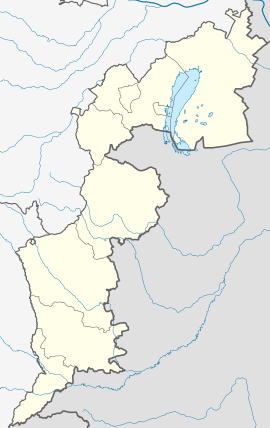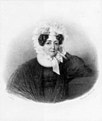Raiding, Austria
Raiding | |
|---|---|
 | |
 Coat of arms | |
 Raiding Location within Austria | |
| Coordinates: 47°34′N 16°32′E / 47.567°N 16.533°ECoordinates: 47°34′N 16°32′E / 47.567°N 16.533°E | |
| Country | |
| State | Burgenland |
| District | Oberpullendorf |
| Government | |
| • Mayor | Markus Landauer |
| Area | |
| • Total | 13.07 km2 (5.05 sq mi) |
| Elevation | 253 m (830 ft) |
| Population (2018-01-01)[2] | |
| • Total | 865 |
| • Density | 66/km2 (170/sq mi) |
| Time zone | UTC+1 (CET) |
| • Summer (DST) | UTC+2 (CEST) |
| Postal code | 7321 |
| Website | www.raiding.at |
Raiding (German pronunciation: [ˈʁaɪdɪŋ]; Hungarian: Doborján, pronounced [ˈdoborjaːn]; Croatian: Rajnof) is a small Austrian market town in the district of Oberpullendorf in Burgenland. It is the birthplace of Franz Liszt.
Geography[]
The municipality lies on Raiding Creek in Middle Burgenland; Raiding is the only borough in the municipality.
History[]
Raiding was first documented in 1425 as Dobornya.
Like the rest of Burgenland, Raiding belonged to Hungary from c. 900 to 1920/21. After the end of the First World War, Western Hungary was given to Austria with the Treaties of St. Germain and Trianon; there it formed the new province of Burgenland.
In 1971, Raiding was merged with Unterfrauenhaid and Lackendorf into a larger municipality, which was later dissolved. Raiding has been a market town since 1990.
Population[]
| Year | Pop. | ±% |
|---|---|---|
| 1869 | 713 | — |
| 1880 | 736 | +3.2% |
| 1890 | 880 | +19.6% |
| 1900 | 928 | +5.5% |
| 1910 | 928 | +0.0% |
| 1923 | 976 | +5.2% |
| 1934 | 1,076 | +10.2% |
| 1939 | 994 | −7.6% |
| 1951 | 964 | −3.0% |
| 1961 | 872 | −9.5% |
| 1971 | 846 | −3.0% |
| 1981 | 801 | −5.3% |
| 1991 | 854 | +6.6% |
| 2001 | 836 | −2.1% |
| 2011 | 836 | +0.0% |
Politics[]
The municipal council has 15 seats with party mandates as follows: SPÖ 9, ÖVP 6, FPÖ 0, Grüne 0, and other lists 0.
Culture and landmarks[]
Business and infrastructure[]
Viticulture is the main business in Raiding. Other industries there include metal construction and soda water production.
Personalities[]
- Paul Iby, Bishop of Eisenstadt
- Adam Liszt ∞ Anna Liszt
- Franz Liszt, composer and musician
Image gallery[]

Birthplace of Franz Liszt in Raiding.

Anna Liszt, Adam's wife (portrait between 1826 and 1837)

Franz Liszt
References[]
- ^ "Dauersiedlungsraum der Gemeinden Politischen Bezirke und Bundesländer - Gebietsstand 1.1.2018". Statistics Austria. Retrieved 10 March 2019.
- ^ "Einwohnerzahl 1.1.2018 nach Gemeinden mit Status, Gebietsstand 1.1.2018". Statistics Austria. Retrieved 9 March 2019.
- Cities and towns in Oberpullendorf District
- Burgenland geography stubs





